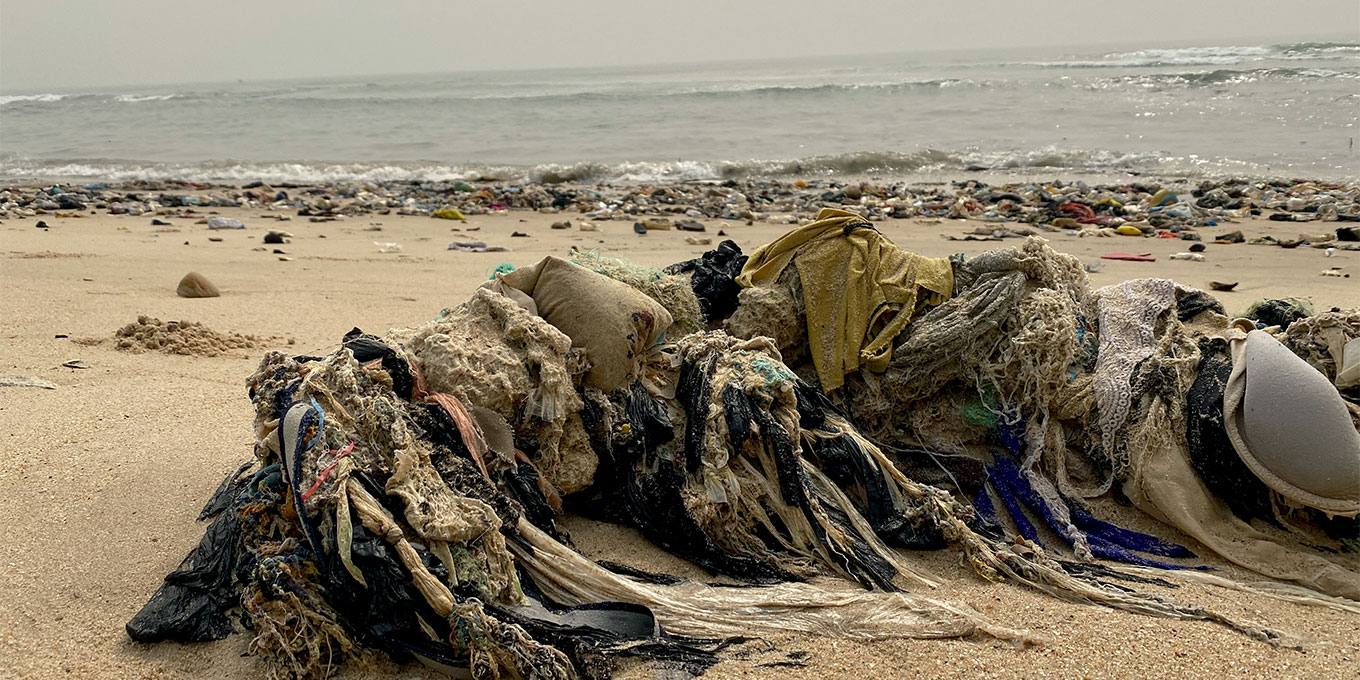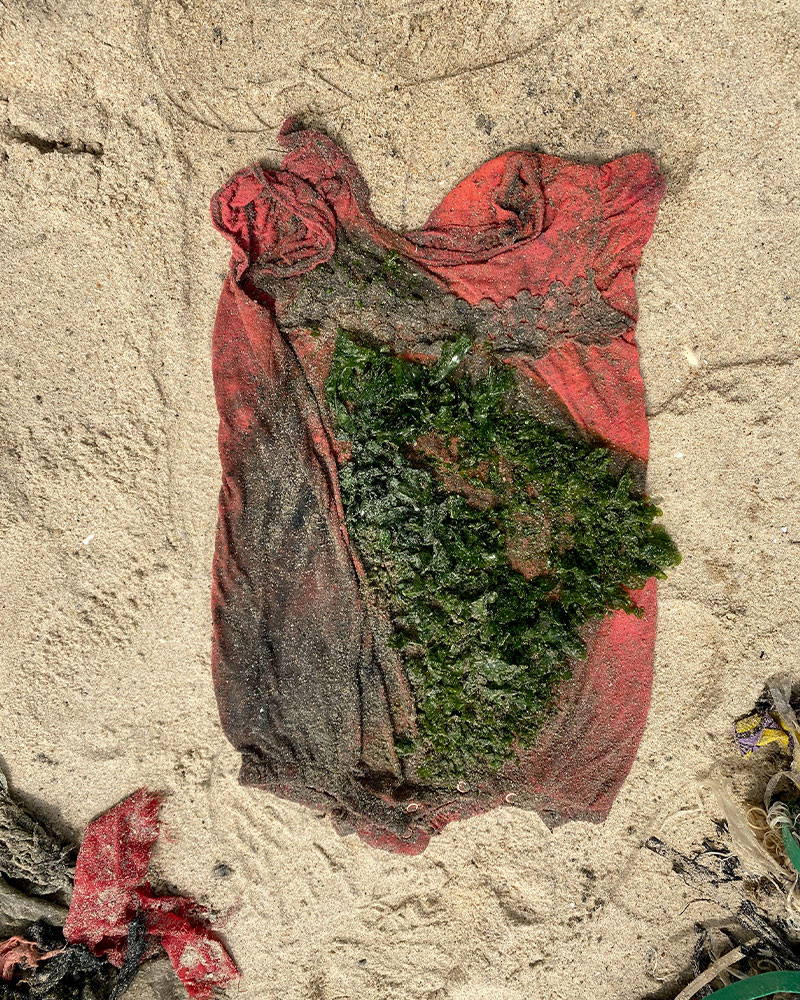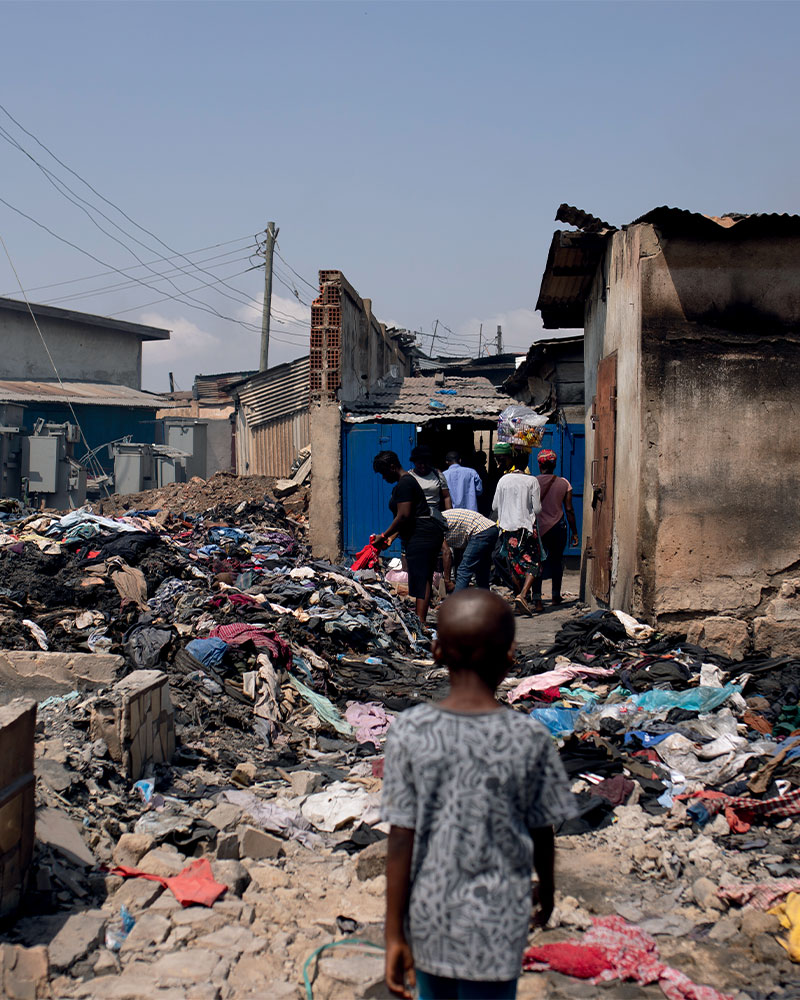Fashion
The Effects of Secondhand Clothing
Though donating our clothes clears our conscience, the practice has a shadowy side with huge environmental repercussions.
by : Marouchka Franjulien- Oct 13th, 2022

PHOTOGRAPHY, COURTESY OF THE OR FOUNDATION
The palm-tree-lined beaches in Accra, the capital of Ghana, were once a paradise. Now, the fine sand is littered with pieces of clothing that wash up by the thousands on the shores of the Gulf of Guinea—a mournful postcard of our overconsumption. Each week, an average of 15 million clothing items arrive by boat, mostly from the U.S., Canada and the U.K. but also from China, South Korea and Australia. While some of these items make their way to markets to be resold, many end up in landfills, where they are eventually carried away by rain into waterways and, inevitably, the ocean. These shipments include various brands’ unsold items, but the bulk of them are from our own wardrobes.
Most clothing that’s donated to charitable organizations never sees the inside of a store. At Quebec-based Renaissance, for example, almost 50 percent of the estimated 11,275 tonnes of clothing received last year couldn’t be sold because it was in poor condition. To get rid of its huge surplus, the organization calls on a network of partners that buy the merchandise to transform it into rags or stuffing or resell it.
This is how your too-small T-shirt can end up on African shores or in Chile, where dunes in the Atacama Desert are now polluted with millions of discarded items. And this is also how your tee can end up in Kantamanto, the vast open-air second-hand market for which Accra is famous. In the labyrinth of colourful stalls, some of the West’s rejects find new buyers. The rest—about 40 percent—will end up in dumps around the city.
Year after year, the standard of the clothes that arrive in Accra declines because of low-quality fast fashion. “The problem is that it’s cheaper to send our waste overseas than to pay for its disposal in a Canadian landfill,” explains Kate Bahen, managing director of Charity Intelligence Canada, an organization that evaluates charities in order to improve transparency in the sector. “Developing countries don’t want our rags, but all attempts to stop [these exports] are met with the strength of [second-hand resale companies] and their powerful international SMART [Secondary Materials and Recycled Textiles] lobby.”
For the vendors at Kantamanto, who are forced to buy bales of pieces for their stalls without knowing what they contain, this drop in quality has been devastating. Each purchase is a lottery that will either allow them to make ends meet or be of very little value. “Usually, these vendors have the [means] to restore damaged items—whether by sewing, dyeing or removing stains—and prevent them from being discarded,” says Liz Ricketts, co-founder and director of The Or Foundation, an Accra-based U.S. non-profit organization that campaigns for ethical and sustainable fashion at all levels of the industry. “However, as the quality of the clothes has declined, the price of the bales and expenses have increased during the pandemic; therefore, sellers no longer have enough money to invest in basic services like repairs, cleaning and ironing.” This vicious cycle has a direct impact on sales and the amount of clothing that gets discarded—which is also on the rise.
 An old piece of clothing in Accra. (COURTESY OF THE OR FOUNDATION)
An old piece of clothing in Accra. (COURTESY OF THE OR FOUNDATION)In the past, unsold items were usually sent to a sanitary landfill managed by the local government, but it caught fire in August 2019. Since then, one- to two-thirds of the waste is picked up by private collectors who send it to other landfills, while the rest ends up burned or tossed into informal dumps. In these wastelands, the refuse accumulates enough to create artificial hills. “One of the dumps we work in is 60 percent clothing, which has created a pile 15 metres high, maybe higher,” says Ricketts. Even though she doesn’t visit these dumps every day, the activist has developed asthma due to the smoke she’s exposed to on her visits. “It says a lot about the environmental consequences of these sites, which pollute the land, the air and the water, not to mention the effects they have on those living nearby,” she says. The problem also extends to nearby waterways, as the rags are pushed by rain into an adjacent river before making their way into the sea. As a result, new synthetic sea creatures are washing up onshore from one end of the country to the other. Ricketts and her team at The Or Foundation have been working to quantify these impacts. The footprint of our clothes clearly continues to grow long after they’ve left our closets. Popular synthetic materials like nylon, elastane and polyester take decades or even centuries to decompose, releasing considerable amounts of methane—a greenhouse gas that contributes significantly to global warming—in the process.
With 2.5 million inhabitants, Accra is far from able to absorb the 15 million articles of clothing that arrive there every week. Along with being sold at the market or ending up in a dump, items are also sent to other West African countries. “It’s important to understand that Kantamanto is the biggest upcycling economy in the world and a model of sustainability,” says Ricketts. “Retailers working in the market not only manage waste from the West but also make sure they upcycle it, so they aren’t sending items in poor condition to other markets. This is proof that most clothes are not trash when you have the skills to mend or dye them.” This philosophy, which guides the 30,000 people who work at Kantamanto, should also inspire us in our own daily lives. Orsola de Castro, co-founder of Fashion Revolution, a U.K. organization that highlights the industry’s excesses on a global scale, is trying to bring about reform by calling for greater transparency in supply chains. She says it’s vital that we rethink how we shop: “We must avoid impulse buying and have a conversation with our wardrobe so that it becomes an active part of our lives.” We can start doing this by taking an interest in how our clothes are made, learning how to clean them properly and mend them or calling on the expertise of a tailor to keep them in good condition for as long as possible. “There’s still a myth that we have nothing to gain from repairing our fast-fashion pieces,” she says. “But even if they’re inexpensive, they deserve to be cared for.”
Fast fashion isn’t in trouble either; just look at companies like China’s cheap-goods giant Shein, which was valued at US$100 billion this year. Each week, its online store receives more than 1,000 new items to meet the ever-increasing demand in the world of social media, where donning a new outfit for each post has become a prerequisite. The brand is hitting hard with increasingly aggressive pricing: A dress on sale costs just under $4, and a brand new pair of jeans is $23. These prices, well below the likes of Zara and H&M, come at the expense of the company’s workers, as well as the environment. A report by Swiss NGO Public Eye revealed that Shein’s employees work 75 hours per week on low salaries in factories with deplorable conditions and get only one day off per month.
 A landfill in Accra that caught fire in 2019. (COURTESY OF THE OR FOUNDATION)
A landfill in Accra that caught fire in 2019. (COURTESY OF THE OR FOUNDATION)This pitiful status quo doesn’t necessarily mean we need to do away with inexpensive clothing altogether. “Fast fashion, which is affordable for the majority of the population, can’t be completely eliminated,” says de Castro. “But we need to ensure that those who make it have the means to live decently. If inexpensive clothes can be made from more environmentally friendly materials in factories that respect the environment and [pay] workers a decent wage, then fast fashion is welcome.” The road to making this utopia a reality is long, though, especially since the onus for change lies with the fast-fashion companies that have made billions by exploiting others and the planet.
De Castro believes all is not lost, though, and that we can start by tempering our consumption by buying fewer, better-quality items and holding on to them for as long as possible. “I wear my clothes until they’re worn out, and then I use them as rags,” says Bahen. “It’s easy to get rid of unwanted items in a donation bin, but ask yourself, ‘Is there a real need for them locally?’ Are you giving away a winter coat or worn-out underwear? My rule of thumb is if I wouldn’t give the item to a loved one, I throw it away. I’d rather it end up in a Canadian landfill than be shipped halfway around the world.” Ricketts takes the idea one step further and calls for a rethink of the circular economy on a global scale. “A lot of clothing ends up in Ghana, but there’s no investment in the community to ensure that it’s actually managed,” she explains. “We need to push for more transparency in the second-hand supply chain, because it is indeed a supply chain and not a charity. We should be asking the same questions and demanding the same kind of justice [as we do with the fashion-industry supply chain].” Just as it’s important to curb the ultra-polluting production of new clothes, it’s crucial to reduce the number of pieces that end up in landfills around the world. The area around Accra is already overflowing with rags that nobody wants, while some fast-fashion companies are talking about setting up factories in the country in the coming years. The idea of finding a tattered dress on a local beach with a “Made in Ghana” tag is chilling—but it could soon be our reality.
Newsletter
Join our mailing list for the latest and biggest in fashion trends, beauty, culture and celebrity.
Read Next

Beauty
The Best Met Gala Beauty Looks Of All Time
From Taylor Swift's 'Bleachella' era to Rihanna's iconic 2011 braids, meet the best beauty moments in Met Gala history.
by : Katie Withington- Apr 26th, 2024

Culture
Benny Blanco Says He Fell in Love With Selena Gomez Without ‘Even Noticing’ It
Allow Benny Blanco to tell the straight-from-a-rom-com story of how he realized his feelings for his girlfriend and longtime friend.
by : Alyssa Bailey- Apr 26th, 2024

Beauty
Tested and Approved: Your New Hydrating Skincare BFF
This new product has all of your skin’s thirst-quenching needs covered.
by : ELLE Canada- Apr 17th, 2024




